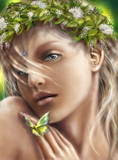Samhain is the most important of all the sabbats because it is the start of the Witches' New Year. It is also the most misunderstood and feared sabbat. At this time of year, the veil between the two worlds is very thin. The altar is decorated with fall leaves, apples, pomegranates, pumpkin, and squash. Usually the third and final harvest is completed by October 30, and many people stockpile food in preparation for the upcoming winter months.
A way to banish negativity at Samhain is by bowl burning. In this ritual, you can write down on a piece of paper that aspect of your life from which you wish to be freed. Place the paper into a bowl and light it on fire. Then ask the Universe to transform this energy from a negative one into a more positive one, thanking the Divine Source ahead of time.
Other traditions include making a besom, leaving a plate of food outside for the souls of the dead, making masks, wassailing, and the two-thousand year-old-tradition of creating jack-o'-lanterns to frighten away evil spirits. Most importantly, fellow Pagans remember with peace and love tho who have crossed over to the other side.
Herbs and flowers associated with Samhain include acorn, chrysanthemum, deadly nightshade, dittany, ferns, flax, fumitory, hazel, heather, mullein, oak leaves, pumpkin, sage, straw, thistle, and wormwood.
Traditional foods of Samhain include pumpkin pie, apples, cakes for the dead, cranberry muffins and bread, pears, pork, red foods, beans, pomegranates, all grains, beets, turnips, corn, gingerbread, mulled wine, meat dishes, hazelnuts, ale, cider, and herbal teas.
by Jamie Wood and Tara Seefeldt
Tuesday, October 12, 2010
Subscribe to:
Post Comments (Atom)



No comments:
Post a Comment